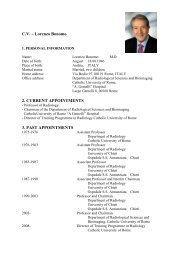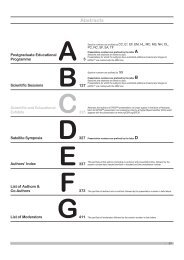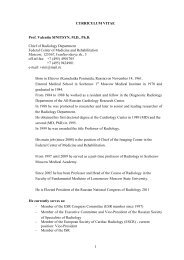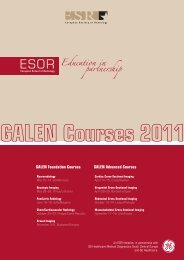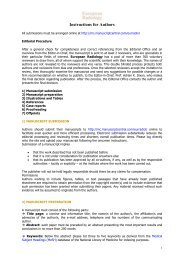Postgraduate Educational Programme - myESR.org
Postgraduate Educational Programme - myESR.org
Postgraduate Educational Programme - myESR.org
- No tags were found...
Create successful ePaper yourself
Turn your PDF publications into a flip-book with our unique Google optimized e-Paper software.
<strong>Postgraduate</strong> <strong>Educational</strong> <strong>Programme</strong>invasive technique which should be considered early in the treatment regime. Itaims to stop the biochemical inflammatory reaction around the nerve root. It is ideallyperformed under image guidance to ensure proper deposition of steroid andto avoid complications. Although periradicular steroid injection has been used fordecades, its efficacy is still controversial. Non-controlled studies report successin 33% to 72% of patients. Short-term benefit of percutaneous nerve root block isquite high with good pain relief especially in irritative radiculopathy. Failure of 4 to 6weeks of conservative therapy and a minimum of one selective image-guided steroidinjection, the treatment is directed to the disc. The minimally invasive percutaneoustechniques in use today, aim at removing a small amount of central nucleuspulposus, so as to reduce intradiscal pressure and thus obviate disco-radicularcompression. several alternative techniques of percutaneous nucleotomy have beendeveloped, relying either on pure mechanical (automated percutaneous lumbardiscectomy), chemical (alcohol, oxygen-ozone) or thermal (Laser, radiofrequency)decompression. Many non-controlled studies with large series report a high successrate of percutaneous thermal nucleotomy with 70 to 89% good results on radicularpain. The three most critical elements for successful nucleotomy are: proper patientselection, correct needle placement and effective cavitation.Learning Objectives:1. To understand possible treatment techniques for disc disease.2. To know more about clinical and imaging findings in treatment.3. To learn about published results on percutaneous disc treatment.Panel discussion:How can imaging methods separate candidates for percutaneoustherapy and surgery? 17:1416:00 - 17:30 Room PVascularRC 315Vascular imaging in ischaemic strokeModerator:J. Hendrikse; Utrecht/NLA-044 16:00A. Intracranial atherosclerotic disease of carotid arteriesT. Jargiello; Lublin/PL (tojarg@interia.pl)Intracranial atherosclerotic lesions of carotid arteries are relatively seldom, especiallywhen compared with extracranial atherosclerosis. According to statistics,intracranial lesions do not exceed 2-3% of all carotid occlusive disease, and ina whole group, less than 1% needs invasive treatment. This means that the roleof intracranial stenotic disease is not big, but still important, especially when notproperly diagnosed. In practice, intracranial carotid lesions are the most frequentlyrevealed during the imaging process for evaluation of extracranial atheroscleroticdisease in patients qualified for carotid stenting or endarterectomy. In patientsqualified for stenting, arteriography (DSA) is the main imaging modality, done rightbefore intervention to look for possible tandem extracranial / intracranial stenosis. Inpatients qualified for open surgery, CT-angio and MR-angio are usually performed toassess intracranial circulation. CT-angio is more popular today (available and lessexpensive) but contrast-enhanced MR-angio (CE-MRA) seems to be superior - beingfree of radiation, iodine contrast medium and has less possible artefacts (skullbas bones). Except stated above, there is a group of patients who are clinicallysuspected with intracranial stenosis with negative extracranial findings. For them,transcranial Doppler examination is a good solution as a screening test. Whenpositive or even not evidently negative, CTA or CE-MRA are adviced. Indicationsfor invasive (endovascular) treatment depend strictly on the degree of stenosis, itslocation and coexistent other stenoses (tandem lesions). These factors are alwaysevaluated together with visible and potential collateral circulation - individally foreach patient.Learning Objectives:1. To become familiar with appropriate imaging protocols for all imaging modalitiesand the pros and cons of each modality.2. To learn about imaging signs of atherosclerotic disease in the carotid arteryterritory.3. To learn about the classification of lesions and indications for treatment.A-045 16:30B. Vertebrobasilar atherosclerotic diseaseL. Valvassori, M. Piano; Milan/IT (Luca.Valvassori@ospedaleniguarda.it)Intracranial atherosclerosis is a systemic and multifactorial disease, associated withatherosclerosis of carotids, coronaries, aorta, renal and iliofemoral arteries. Overone-third of ischaemic strokes occur in the posterior circulation, a leading causeof which is atherosclerotic vertebrobasilar (VB) disease. Symptomatic VB diseasecarries a high annual risk of recurrent stroke, averaging 10-15% per year, despitemedical therapy. VB stroke is particularly prone to devastating consequences dueto the eloquence of the regional brain tissue and is associated with high rates ofdeath and disability. More common in older age and in Western countries, withoutdifferences of gender. CTA and/or MRA are excellent screening tool, but DSA is thegold standard to show focal stenosis, luminal irregularities, thrombosis, occlusion,arteries ectasia and elongation, serpentine aneurysms. Transient ischaemic attack,along with severe stenosis and progressive occlusion, are most common symptoms.An important stroke mechanism in VB atherostenosis is regional hypoperfusion.Furthermore, both embolic and flow processes can synergize to increase strokerisk, reducing the wash-out of emboli from the distal circulation in hypoperfusedregions. Posterior circulation collateral channels may maintain adequate distal flow.The existence and extent of these compensatory blood flow pathways, evaluatedby DSA, may influence the risk of stroke. Percutaneous angioplasty and stentingfor symptomatic atherosclerotic VB stenosis is a feasible and effective therapeuticmethod, but good experience and full understanding of neurology and haemodynamicsare required, as well as for diagnostic purposes.Learning Objectives:1. To learn about the appropriate imaging protocol and the imaging signs ofextracranial and intracranial atherosclerosis.2. To learn about the epidemiology, symptomatology and natural history.3. To learn about the classification of lesions and indications for treatment.A-046 17:00C. Dissection and vasculitis of intracranial and extracranial arteriesH.R. Jäger; London/UK (r.jager@ion.ucl.ac.uk)Dissection of the cervical arteries is a major cause of stroke in young adults andmay also present with headache, neckpain, cranial nerve palsies. Intradural dissectionscan cause subarachnoid haemorhage. 80% of carotid artery dissectionsare extracranial and 20% are intracranial; vertebral artery dissections occur mostoften in the atlas loop or at the junction of the V2/V3 segments. Dissections arecasued by a tear in the intima leading to an intramural haematoma which resultsin an expansion of the external vessel diameter with a variable degree of luminalnarrowing. Compromise of the arterial lumen and complications, such apseudoaneurymformation, are visualised with angiographic techniques (CTA and MRAnow mostly replacing DSA). The intramuralhaematoma can be directly visualisedwith cross-sectional CT and MR. The MR signal intensity of the heamatoma is timedependent:it is T2- and T1- hypo- or isointense in the acute stage before becomingT2- and T1-hyperintense in the subacute stage. Cerebral vasculitis of the largeand medium-sized intracranial vessel causes segmental narrowing or “beading” ofthe intracranial vessels which is readily demontrated on CTA and high-resolutionintracranial MRA. Reversible Cerebral Vasoconstriction Syndrome (RCVS) is animportant differential diagnosis for these appearances. Cerebral vasculitis affectingthe small vessels (< 300 µm) is often difficult to diagnose, even on high-resolutionDSA, and frequently requires confirmation with brain biopsy. Haemodynamic compromisecaused by arterial dissections or by cerebral vasculitis can be assessedwith CT perfusion and MR perfusion imaging.Learning Objectives:1. To learn the imaging signs of dissection and different types of large/mediumvessel vasculitis.2. To learn about lesion morphology and haemodynamic consequences of dissectionand vasculitis.3. To learn about imaging protocols for detection of dissection and large/mediumvessel vasculitis.ThursdayAB C D E F GS15




